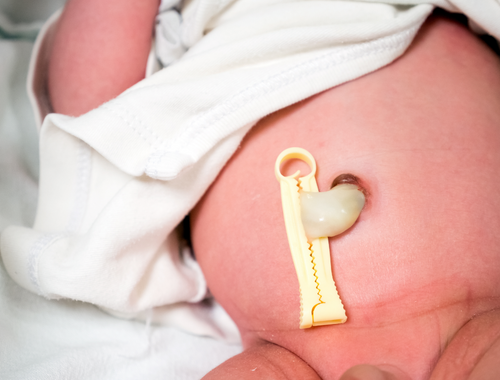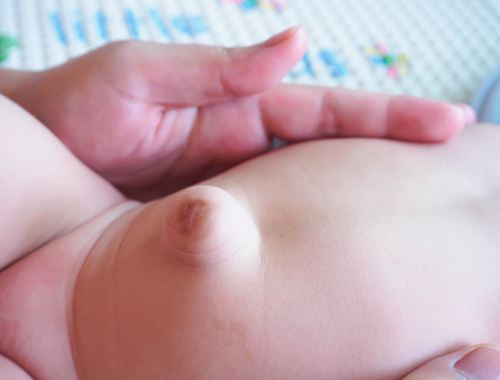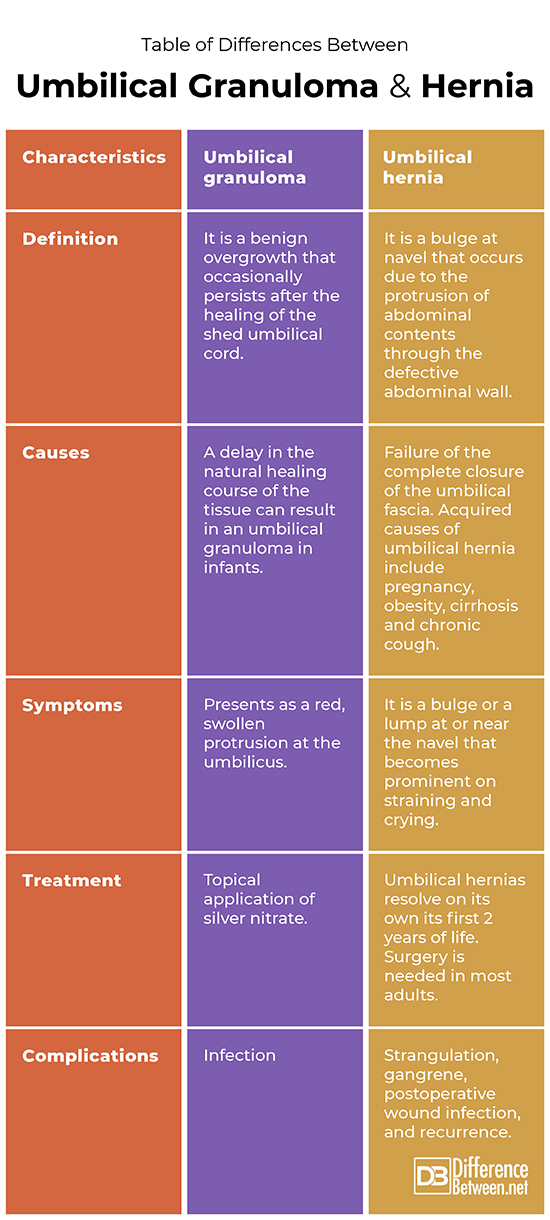Difference Between Umbilical Granuloma and Hernia
An umbilical granuloma is a benign overgrowth that occasionally persists after the healing of the shed umbilical cord. Umbilical hernia, on the other hand, is a bulge at navel that occurs due to the protrusion of abdominal contents through the defective abdominal wall.

What is an Umbilical Granuloma?
Definition:
An umbilical granuloma is a small, harmless, moist lump at the navel that forms in some infants as the belly button heals.
Epidemiology of Umbilical granuloma:
Umbilical granulomas can occur in 1 out of 500 infants.
Causes and diagnosis of Umbilical granuloma:
The exact cause of umbilical granulomas is yet to be known. After the delivery of the fetus, the umbilical cord is cut, and a section is left off to heal on its own. It is believed that an umbilical granuloma results due to the disturbance in the healing process of the umbilicus, leaving off a scar or a stump. No hereditary factors are involved in this condition. Physicians diagnose the granuloma visually via inspection and examination of the periumbilical region. Rarely, a small biopsy of the lump might be needed to confirm the lesion.
Symptoms of Umbilical granuloma:
The umbilical granuloma normally appears as a red, non-tender, moist mass. Sometimes this can get infected and may present with oozing yellow discharge or pus and infective symptoms like fever and discomfort might begin. Urgent hospital visit is encouraged in such circumstances.
Treatment of Umbilical granuloma:
The mainstay treatment of umbilical granuloma is the application of silver nitrate. Silver nitrate dries up the tissue and aids in it falling off. If topical therapy is unresponsive after two to three attempts, surgical excision may become necessary.
Complications related to Umbilical granuloma:
Infection of the umbilical granuloma needs prompt treatment, as it is a frequently encountered complication. Red flags of infection include a high-grade fever, bloody or foul-smelling discharge from the granuloma, rash around the navel or a painful, swollen periumbilical area. In such cases, antibiotics might be needed.

What is an umbilical hernia?
Definition of umbilical hernia:
A defect in the abdominal wall near the navel can cause the intestinal contents to sometimes bulge out, resulting in umbilical hernia.
Epidemiology of umbilical hernia:
Umbilical hernia is common in both children and adults. 10-30% of Caucasian children population have this condition whereas in African American infants, the prevalence is 23-85% at birth. Premature, low birthweight infants are more susceptible to have the defect as compared to term babies. On the other hand, 2% of the total adult population has umbilical hernia.
Causes and diagnosis of umbilical hernia:
In newborns, incomplete fusion of the fascia of the umbilical ring can result in the formation of an umbilical hernia. The abdominal contents hence protrude out of the defect. In adults, 90% cases of umbilical hernia are acquired whereas 10% have carried the condition from childhood. Conditions which increase intrabdominal pressure such as obesity, multiparity, chronic cough and ascites tend to augment the risk of acquired umbilical hernias.
A doctor can diagnose umbilical hernias on physical examination. Radiological modalities such as ultrasound and CT scan are sometimes needed to determine the size, extent, and the nature of the hernia contents.
Symptoms of umbilical hernia:
Typically, umbilical hernias present as a harmless bulge on the navel. These may protrude out on straining, coughing, and laughing and move back in on lying. In case of complications, the hernia might become painful and irreducible and can present with nausea and vomiting.
Treatment of umbilical hernia:
In majority of childhood cases, the hernia resolves on its own in the first 2 years of life. Symptomatic pediatric hernias need to be dealt with surgery after 4 to 5 years of life. In adults, umbilical hernias would not resolve on its own and hence surgery is always opted for.
Complications involved umbilical hernia:
Strangulation and gangrene are notorious complications of umbilical hernias in which the blood supply to the abdominal contents becomes disrupted. Emergency surgery needs to be prompted in such cases. Other complications of umbilical hernia include post operative wound infections and recurrence.
Difference between umbilical granuloma and umbilical hernia
Definition of umbilical granuloma vs. umbilical hernia
An umbilical granuloma is a harmless overgrowth or stump that remains after the cut umbilical cord is in its healing phase.
Umbilical hernia is a bulge at the navel that occurs due to protruding intestinal contents from the defective abdominal wall.
Causes related to umbilical granuloma vs. umbilical hernia
A delay in the natural healing course of the tissue can result in an umbilical granuloma in infants.
Umbilical hernias exist due to failure of the complete closure of the umbilical fascia. Acquired causes of umbilical hernia are the conditions which increase the intraabdominal pressure.
Symptoms associated with umbilical granuloma vs. umbilical hernia
Umbilical granuloma presents as a red, swollen protrusion at the umbilicus.
Umbilical hernia is a bulge or a lump at or near the navel that becomes prominent on straining and crying.
Treatment involving umbilical granuloma vs. umbilical hernia
Umbilical granuloma requires topical application of silver nitrate to heal. Umbilical hernias resolve on its own its first 2 years of life. Surgery is needed in most adults.
Complications due to umbilical granuloma vs. umbilical hernia
Infection is the main complication of umbilical granuloma. Strangulation, gangrene, postoperative wound infection, and recurrence are common complications of umbilical hernia.
Table of the differences between Umbilical granuloma and hernia

FAQs:
What does an umbilical granuloma look like?
An umbilical granuloma appears as a red, moist lump at the belly button. It is painless and harmless.
When should I be concerned about my umbilical granuloma?
If the granuloma starts to bleed, has a foul smell, or has a pussy discharge then it can be suspicious. Look out for signs of infection such as a high-grade fever or pain at the umbilical region.
Do umbilical granulomas go away?
Most umbilical granulomas resolve on their own. Some might need treatment with silver nitrate or in severe cases surgery.
How serious is umbilical granuloma?
This condition is benign and does not harm the baby. However, if infection develops then urgent treatment is adjourned.
What can be mistaken for an umbilical hernia?
Umbilical hernia can be mistaken for an inguinal hernia, an epigastric hernia or a lipoma. Thorough physical examination is necessary to distinguish between these conditions.
Are umbilical hernias hard or soft?
Umbilical hernias are soft masses.
How do you tell if a lump is a hernia?
Hernia presents as a lump or a bulge in an area, typically the abdomen or groin. Physical examination and history are important to tell if the lump is a hernia. Signs such as reducibility and protrusion on straining can help in diagnosis. Symptoms such as pain, nausea and vomiting need to be evaluated. Finally, ultrasound and CT scan can confirm the diagnosis.
What does the beginning of an umbilical hernia look like?
Umbilical hernia presents as a lump in the belly button that becomes prominent on straining and goes back in on lying or when relaxed.
- Differences Between Reptiles and Amphibians - May 17, 2024
- Difference Between Ophthalmology and Optometry - May 15, 2024
- Difference Between Fear and Anxiety - April 2, 2024
Search DifferenceBetween.net :
Leave a Response
References :
[0]Snyder, Charles L. “Current management of umbilical abnormalities and related anomalies.” Seminars in pediatric surgery vol. 16,1 (2007): 41-9.
[1]Coste, Anouchka H., Sahned Jaafar, and John D. Parmely. "Umbilical hernia." (2017).
[2]Densler, J. F. "Umbilical hernia in infants and children." Journal of the National Medical Association 69.12 (1977): 897.
